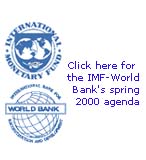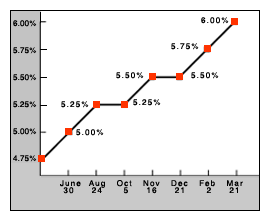|
Fed's Meyer sees risks
|
 |
April 12, 2000: 2:44 p.m. ET
Booming U.S. economy threatening to ignite inflation, Fed governor says
|
NEW YORK (CNNfn) - Federal Reserve Governor Laurence Meyer on Wednesday said there was a huge risk of overheating in the booming U.S. economy, further fueling conviction on Wall Street that the central bank is leaning toward raising interest rates further in the months ahead.
"The balance of aggregate demand and sustainable supply today and the distinct possibility that labor and product markets will tighten further suggest an unacceptable risk of overheating and, therefore, higher inflation in the future," Meyer told the Toronto Association for Business and Economics in Toronto.
Meyer, one of the Fed's leading inflation "hawks," added that as long as uncertainties about the economy's future path persisted and the Fed was focused on preempting faster inflation, its gradual policy of step-by-step rate rises was the best way to achieve balance between demand and supply.
But if already apparent imbalances in the U.S. economy should become even more glaring, the central bank should be ready to begin lifting short-term rates more aggressively, he warned. The Fed has raised short-term rates five times since last June, moving them up by quarter-point steps. It is widely expected to lift rates again at its May 16th meeting.
IMF advises Fed
Meyer's remarks came on the heels of the International Monetary Fund's semi-annual economic outlook, which forecasts U.S. growth to remain robust this year before cooling off slightly in 2001. The report offers a fiscal and economic analysis of its 182 member countries and is released at the IMF-World Bank's spring and fall meetings.
 The report also had some advice for the Fed: keep raising interest rates to reign in the robust U.S. economy and steer it toward a "soft landing," where the pace of growth will abate, but not stall completely. The report also had some advice for the Fed: keep raising interest rates to reign in the robust U.S. economy and steer it toward a "soft landing," where the pace of growth will abate, but not stall completely.
The U.S. central bank "probably needs to continue to move progressively but prudently to a tighter monetary stance," the IMF said in its World Economic Outlook. The report was distributed as part of the meetings being held this week in Washington.
Although recent declines in the value of technology stocks may have alleviated some of the pressure, the group said it's still worried that rapid credit growth, a widening current account deficit and record-low household savings could send the U.S. economy into an inflationary spiral.
The wealth effect
"In light of these considerations, it seems that monetary policy will have to strike a fine balance between the need to bring output growth in line with potential to keep inflationary pressures at bay, and that of preventing an abrupt correction in asset markets which could likewise be macroeconomically destabilizing," the IMF said.
Indeed, Meyer acknowledged that so far at least, the Fed's rate rises have had little effect on the red-hot U.S. economy, partly because a big run-up in U.S. equity prices that has put new wealth into consumers' pockets.  "Indeed ... the economy appears to have shifted into a still higher gear just as monetary policy turned more restrictive," he said. "Indeed ... the economy appears to have shifted into a still higher gear just as monetary policy turned more restrictive," he said.
"Because there are still limits to how fast the economy can grow without further straining labor markets and to how long the unemployment rate can go without triggering higher inflation, there are limits to monetary policy's tolerance for above-trend growth and for further labor market tightening," he said.
The U.S. economy expanded at a 7.3 percent pace in the final quarter of 1999, the strongest showing in 16 years.
-- from staff and wire reports 
|
|
|
|
|
 |

|

